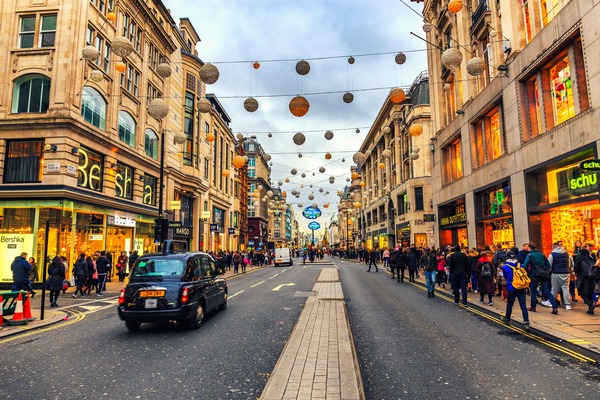 Naeem Arif is a highly experienced customer-orientated leader, with over 15 years experience as director of multiple successful Private Limited Companies in the Retail and Management Consulting world. He the founder of NA Consulting, a retail and management consultancy, and the Co-Founder and Vice Chair of the Midlands Retail Forum.
Naeem Arif is a highly experienced customer-orientated leader, with over 15 years experience as director of multiple successful Private Limited Companies in the Retail and Management Consulting world. He the founder of NA Consulting, a retail and management consultancy, and the Co-Founder and Vice Chair of the Midlands Retail Forum.
2019 looks set to break the boundaries between digital and physical retail. Smartphones give consumers 24 hour access to the digital world, eMarketer predicts 38% of retail ecommerce sales will take place on a mobile device by 2018. The lines between purchasing in store and online are starting to blur, with many consumers using both mediums to create a new form of retail shopping. Many consumers now look to order online through smartphones and pickup in store.
The evolving technology and ecommerce trends present retailers with many challenges; however, for those savvy retailers the chance to transform the standard of customers experience is there to be taken.
Here are the seven retail trends of 2019 that show how interconnected the shopping experience has become for consumers.
Connected Commerce
The modern consumer doesn’t distinguish between online or offline shopping; they consider it all as ‘shopping’. What this means for retailers is that consumers will want to order groceries on their smartphone or desktop and pick them up from the nearest store or pay for gifts in store and have them delivered to their homes. For this reason, retailers should create experiences so frictionless that consumers don’t think about how the process is happening.
To ensure that the customer experience runs smoothly, retailers need to stop looking at their physical stores and online presence as separate entities and look to create a seamless omnichannel experience. In order to create an omnichannel experience, products are synced across all channels and ‘troubleshoot’ their customer’s journey to ensure every step is smooth.
Fintech
Consumers are using mobile devises in all aspects of life, particularly when deciding on how they will purchase online or in-person. The improvements to fintech have seen an explosion of contactless payment options in-stores. The UK Cards Association reporting that shoppers spent £2.32 billion last year using contactless payments, and this figure is set to grow. The popularity of mobile use increases and retailers need to embrace the move to a more seamless payment experience.
With the ever growing use of mobile wallets (Apple, Android and Samsung) retailers are pushing more contactless payment methods into stores. Visa Europe state that mobile payments will reach over £1.2 billion per week by 2020. This is why so many retailers see the opportunity that contactless payments can make. With a quicker payment process consumers may look to stay and spend when they might otherwise be put off by long wait times.
Data and Analytics
Data and analytics is nothing new in the world of ecommerce, however, brick and mortar stores have been able to achieve the same level of data analysis with the introduction of technologies including; people counters and instore analytics.
Brick and mortars are now able to achieve the same level of data analysis, helping them move away from operations-driven methods such as; doorway counters and transactional data. The introduction of technology like Walkbase, uses a Wi-Fi based system to ping devices with Wi-Fi enabled (smartphones or tablets). This system tracks customers in stores, identifying patterns in behaviour.
Retailers can use the information provided to test the impact of merchandising and the store layouts that produce more sales and better customer flow.
Understanding where customers will go in stores helps retailers to identify areas of the store that are visited frequently and areas they are not. This allows stores to plan merchandising and push new products in areas with higher foot traffic.
Retail Security and Loss-Prevention Solutions
The increase of devices connected to the internet has forced retailers to be increasingly reliant on mobile devices; a system crash could be devastating to all retailers no matter how big or small.
In the event of data breaches, retailer’s websites and POS systems present a huge concern to retailers and customers. Tripwire’s research suggests retailers are being overconfident in their ability to detect and prevent breaches, making them more vulnerable.
The implementation of breach detection tools like anti-virus software, intrusion detection systems, malware detection, white listing and file-integrity monitoring software. Tripwires research shows, 59% of retail respondents admitted that their breach detection tools we only partially implemented. Despite the increasing risks in recent years, a large majority of retailers have failed to ensure security measures are prepared. Looking at how to develop security offline to prevent theft from shoplifters and even employees require implementing video cameras, with the aim to identify thieves and to deter them.
Video analytics and improved surveillance technology is helping retailers of all sizes to improve security. With advanced video surveillance system, monitoring in-store movements of customers and staff. Analytics programs can detect patterns and alert security teams to suspicious behaviour.
Shoppable Content
Shoppable content will become a hot topic in 2019, with consumers looking for a more unique experience. Personalised journeys through social media commerce such as Pinterest ‘buy buttons’ and direct links on Instagram and Twitter will be a key object for many retailers, particularly those in fashion, partly due to millennials entering prime spending years. Enabling shoppers to make purchases from any location will satisfy their instant gratification needs and will also help cater to their lifestyle through a frictionless and enjoyable purchase process.
Connecting with customers through combining publishing with commerce has been used by retailers for years, with the creation of blogs and social media content. As this becomes more sophisticated, retailers are beginning to realise that content creation can’t just be used to attract and entertain customers, it needs to convert them.
This is where shoppable content creates purchasing and browsing, with customers able to add to their virtual shopping cart without interrupting the content they were expecting. What makes shoppable content different from traditional content is that customers can use pop-ups to choose item quantity, size or colour without them leaving the content they are currently viewing. This creates a frictionless process allowing customers to travel through multiple web tabs and lose track of where they want to be.
Retail Management Solutions
Many would argue that retailers have been too focused on the consumer, with mobile marketing, location based marketing, proximity marketing, apps, mobile commerce, social media, channel development etc. Whilst this can be beneficial, some retailers have lost focus on what their stores can offer. Simply having technology that engages and inspires customers is great, but retailers need technology that helps create efficient and effective operations, increase profitability and enhance the customer experience.
Retailers now must look at how to leverage technology to better support their network stores. Systems that can improve communication between stores and head office, retailers will gain greater insight into the issues and barriers to operational excellence.
Real-time dashboards provide a snapshot view of the state of the chain providing retailers with the analysis showing the root causes of recurring issues. Retailers can be more effectively supporting their stores and quickly eliminate the problems that constantly tie up managers and staff. Improving the way stores operate allows store teams to feel more motivated and empowered when they know that once a concern is raised, an appropriate resolution is actually actioned.
For retailers to stay competitive they need to remember their frontline staff. These are the people delivering the brand experience to customers every day. Retailers can use technology to better understand what’s happening in their stores and use this information to protect and improve customer experience, which will help strengthen customer loyalty.
Fulfillment tech
Consumers are spending more and more time discovering and researching products online and often these consumers still want to fulfil their orders with local pickups. This presents retailers with an opportunity for online to local shopping experience. Retailers can look to improve their online to local purchasing by ensuring that in-stock products are discoverable online and available for click and collect purchasing.
Retailers who look to use modern EPOS (electronic points of sale) systems are increasingly seeing value over time. The newer generations of EPOS are enabling shops to easily access and benefit from third party services, who have integrated with EPOS. Services like Xero, LoyalZoo, MailChimp and PocketHighStreet technologies are adding value to local shops. Customer expectations are now higher than ever before due to the amount of times and money being spent online.
Fulfilment Technology allows high streets retailers to reach a huge number of customers, who research and discover products online but still prefer to buy locally. Click and collect offer shoppers the convenience of searching online to find in stock products saving time visiting a store and being disappointed. The click and collect service is shown to be far more popular in the UK with 35% of online shoppers having used the service compared to the 13% in the US and 5% in Germany. This figure looks set to jump to 76% over the next three years, as the desire for convenience and speed is becoming the biggest drive of fulfilment trends.
The increase in online and local pick-up and delivery has seen some customers expecting delivery within one day with an online order. Delivery apps and local courier services are making same-day delivery possible for all retailers no matter how small. As this type of shopping increases high street retailers must see the possibility for upselling, either through desktop or mobile app and when customer pick up orders.
Retailers must remember that customers expect a seamless experience regardless of the channel they are using. Whether the customers experience is digital or in-store, it needs to be consistent. To take advantage of new fulfilment technologies retailers must streamline their process rather than simply adding a new service. If a brand was to see its delivered promises being delayed or interrupted by clunky fulfilment systems, this will fall short of the customer’s expectation.




































